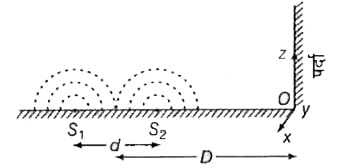
Interference of light is based on the superposition principle according to which at a particular point in the medium the resultant displacement produced by two or more light waves is the vector sum of the displacement produced by the two individual light waves.
A British physicist Thomas Young made two pin holes S1andS2, separated by a very very small distance 'd' on an opaque screen which were illuminated by another pin hole S lit by a monochromatic source of light. so S1andS2 behaves as two coherent sources of light. spherical waves emanating from S1andS2 produce interference fringes on the screen AB. if P be a point situated at a distance x from central point O of the screen, then path difference between the waves coming from the two sources is
S2P−S1P=xdD
Bright fringe is obtained on the screen if path difference xdD is an integer multiple of wavelength λ. However, we get a dark fringe on the screen if the path difference is an odd multiple of λ2.
Q. What is constructive interference ?
When two superposing waves are in same phase, the resultant amplitude and hence intensity of light is maximum and this is termed as constructive interference.
Topper's Solved these Questions
- WAVE OPTICSBook:U-LIKE SERIESChapter:WAVE OPTICSExercise:MULTIPLE CHOICE QUESTIONS
Explore 30 Videos
- WAVE OPTICSBook:U-LIKE SERIESChapter:WAVE OPTICSExercise:FILL IN THE BLANKS
Explore 13 Videos
- WAVE OPTICSBook:U-LIKE SERIESChapter:WAVE OPTICSExercise:ADDITIONAL EXERCISE
Explore 13 Videos
- SEMICONDUCTOR ELECTRONICS : MATERIALS, DEVICES AND SIMPLE CIRCUITSBook:U-LIKE SERIESChapter:SEMICONDUCTOR ELECTRONICS : MATERIALS, DEVICES AND SIMPLE CIRCUITSExercise:SECTION B
Explore 1 Video
Similar Questions
Light waves appear to travel in straight lines since
View SolutionThe wavefront coming from a point source of light is a ______wavefront.
View SolutionYou have learnt in the text how Huygens' principle leads to the laws of reflection and refraction. Use the same principle to deduce directly that a point object placed in front of a plane mirror produces a virtual image whose distance from the mirror is equal to the object distance from the mirror.
View SolutionThree photo diodes D1,D2andD3 are made of semiconductors having band gaps of 2.5 eV, 2eV and 3eV respectively. Which of them will not be able to detect light of wavelength 600 nm?
View SolutionConsider two waves passing through the same string. Principle of superposition for displacement says that the net displacement of a particle on the string is sum of the displacements produced by the two waves individually. Suppose we state similar principles for the net velocity of the particle and the net kinetic energy of the particle. Such a principle willl be valid for
View SolutionIn the case of light waves from two coherent sources S_(1) and S_(2) , there will be constructive interference at an arbitrary point P, the path difference S_(1)P - S_(2)P is
View Solutionदो कला - सम्बन्ध स्त्रोत S1 तथा S2 एक ही कला में तरंगदैर्घ्य λ की प्रकाश तरंगे उत्पन्न करते है तथा उनके बीच की दूरी 2λ है S2 से गुजरती और S1S2 पर लंबरेखा के बिंदुओं पर विचार करे | S2 से वह न्यूनतम दूरी निकाले जहाँ तीव्रता न्यूनतम हो ।
View SolutionThe process of vector addtion of individual displacements of light waves at a point when two or more than two waves arrive at two points is
View SolutionTwo sources wave S_(1) and S_(2) having zero phase difference coming from an isolated light source produces interference. If the common wavelength of the two source be lambda then it is observed that a destructive interference has been taken place at point P. The value of (S_(2)P-S_(1) P) is
View Solutionदो प्रकाश - स्त्रोत कलासम्बन्ध है, यदि ये जो तरंग उतपन्न करते है, वे है
View Solutionएक विद्यार्थी ने यंग द्वि - स्लिट वाले प्रयोग करते समय दो स्लिटों की जगह एक बड़ी समतल अपारदर्शी पट्टी को x - y तल पर रख दिया | इस पट्टी में दो छोटे छिद्र हैं जो 600 नैनोमी तरंगदैर्ध्य प्रकाश उत्पन्न करने वाले दो कला सम्बद्ध बिंदु स्रोतों (S1,S2) के समान हैं |
विद्यार्थी ने गलती से पर्दे को x - z तल (z>0) के समान्तर S1S2के मध्य बिंदु से D = 3 मी की दूरी पर रख दिया, जैसा कि व्यवस्था चित्र में दिखाया गया है | सोतों के बीच की दूरी d=0.6003 मिमी है | S1,S2 को जोड़ने वाली रेखा जहाँ पर्दे से मिलती है वहाँ पर मूलबिंदु O है | पर्दे पर तीव्रता प्रतिरूप के लिए निम्नलिखित में से कौन - सा/कौन - से कथन सत्य है/हैं?

View SolutionTwo coherent sources of light interfere and produce fringe pattern on a screen . For central maximum phase difference between two waves will be
View SolutionTwo coherent point sources S1 and S2 are separated by a small distance 'd' as shown. The fringes obtained on the screen will be :
View SolutionTwo coherent waves of light produce
View SolutionIn the case of light waves from two coherent sources S1 and S2, there will be constructive interference at an arbitrary point P, the path difference S1P−S2P is
View SolutionAccording to a principle, at a particular point in a medium, the resultant displacement produced by a number of waves is the vector sum of the displacements produced by each of the waves. Name the principle.
View Solution

